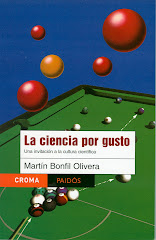Published in Milenio Diario, August 12, 2009
 On August 6, the main science note on almost all media was a study of the genetic material of the human immunodeficiency virus, HIV.
On August 6, the main science note on almost all media was a study of the genetic material of the human immunodeficiency virus, HIV.
The bad news is how this discovery was reported. Some sample headlines: "HIV genome deciphered"( BBC, picked up by newspapers such as Publimetro and radio shows like Hoy por hoy en la ciencia (Today in science), from UNAM and W Radio); "HIV genome, deciphered" ( El Clarín, Argentina). What is the problem? That it is incorrect: the full genome of HIV was decoded about 10 years ago. (A Mexican blog on internet even mentioned that "it has been confirmed that HIV uses RNA -ribonucleic acid- instead of DNA -deoxyribonucleic acid", something that has been known since the eighties.)
Some other media were more precise, though still not so clear: MILENIO Diario mentioned "the first HIV full map", "to create an image, not only of RNA nucleotides, but the forms and folds of the RNA strands". Excélsior, with the information from EFE news agency, used the following header: "AIDS virus genome structure decoded". And Spanish El mundo digital headlined "HIV genome, at bird's eye", and explained that "for the first time, the complete structure of HIV's genome was decoded and they got a clear image of its internal architecture".
Let's explain briefly:
HIV, unlike most organisms, does not have genes made of DNA , the famous double helix molecule, but of RNA, formed by only one chain, not two. The chemical links that form this chain are the "letters" in which genetic information is written, and this is what was deciphered years ago.
The discovery of researchers from
 When the virus penetrates a cell and its genetic information is read, these "knots" and rolls (technically known as "secondary structure") can delay the reading of the genes, and this can be fundamental to control how HIV proteins are manufactured.
When the virus penetrates a cell and its genetic information is read, these "knots" and rolls (technically known as "secondary structure") can delay the reading of the genes, and this can be fundamental to control how HIV proteins are manufactured.
In other words, a kind of "hidden code" was discovered on the virus' genome, which can be important not only to fight it, but also to better understand the control of genetic information in all types of organisms.
Unfortunately, to explain this with the necessary detail, more space is required than is normally available in news media. At the very least, we should try to be as precise as possible.
(translated by Adrián Robles Benavides) To receive Science for pleasure weekly
in your email, subscribe here!




No comments:
Post a Comment